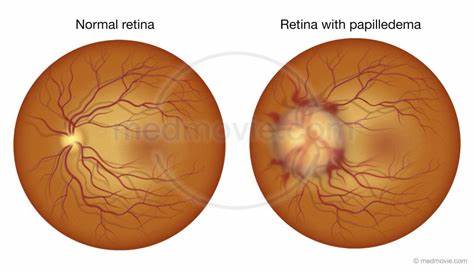Makindo Medical Notes.com |
|
|---|---|
| Download all this content in the Apps now Android App and Apple iPhone/Pad App | |
| MEDICAL DISCLAIMER:The contents are under continuing development and improvements and despite all efforts may contain errors of omission or fact. This is not to be used for the assessment, diagnosis or management of patients. It should not be regarded as medical advice by healthcare workers or laypeople. It is for educational purposes only. Please adhere to your local protocols. Use the BNF for drug information. If you are unwell please seek urgent healthcare advice. If you do not accept this then please do not use the website. Makindo Ltd | |
Papilloedema
-
| About | Anaesthetics and Critical Care | Anatomy | Biochemistry | Cardiology | Clinical Cases | CompSci | Crib | Dermatology | Differentials | Drugs | ENT | Electrocardiogram | Embryology | Emergency Medicine | Endocrinology | Ethics | Foundation Doctors | Gastroenterology | General Information | General Practice | Genetics | Geriatric Medicine | Guidelines | Haematology | Hepatology | Immunology | Infectious Diseases | Infographic | Investigations | Lists | Microbiology | Miscellaneous | Nephrology | Neuroanatomy | Neurology | Nutrition | OSCE | Obstetrics Gynaecology | Oncology | Ophthalmology | Oral Medicine and Dentistry | Paediatrics | Palliative | Pathology | Pharmacology | Physiology | Procedures | Psychiatry | Radiology | Respiratory | Resuscitation | Rheumatology | Statistics and Research | Stroke | Surgery | Toxicology | Trauma and Orthopaedics | Twitter | Urology
Related Subjects: |Brain tumour s |Astrocytomas |Brain Metastases |Tuberous sclerosis |Turcot's syndrome |Lhermitte Duclos Disease |Oligodendroglioma |Acute Hydrocephalus |Intracranial Hypertension |Primary CNS Lymphoma (PCNSL)
Requires emergency referral to ophthalmology for assessment and brain imaging as needed which must include assessing veins so needs MRV or CTV to exclude cerebral venous thrombosis. The main mechanism of optic nerve damage is intraneuronal ischaemia secondary to axoplasmic flow stasis and failure to act can result in loss of vision

About
- Venous outflow obstruction or inflammation
- Swelling and oedema of the optic nerve
- Inflammatory / demyelination
- Raised Intracranial pressure
Causes
- Raised ICP
- Brain tumour : both supra and infratentorial tumour s.
- Brain abscess, oedema
- Haemorrhage ICH or SAH , SDH, EDH
- Encephalitis, Hydrocephalus
- Cerebral venous thrombosis
- Sarcoidosis, Guillain Barre syndrome (high CSF protein)
- Idiopathic intracranial hypertension
- Malignant hypertension
- Retro-orbital lesion (cavernous sinus thrombosis)
- Inflammation (optic uveitis)
- Ischaemia (accelerated HTN)
- CO2 retention
Pseudopapilloedema
- Optic disc drusen and optic nerve head drusen simulates some features of papilloedema but is secondary to an underlying, usually benign, process.
- Congenital anomalies of the optic disc
- Optic disc infiltration by neoplastic or inflammatory cells
- Down syndrome
The assessment of optic discs can be difficult, even in expert hands, but it is important to make some attempt at examining them. Usually, dilatation is not necessary, but in exceptions topical 0.5% tropicamide can be used (see BNF www.bnf.org) please indicate that a mydriatic has been used in the notes, as this can be a source of confusion if the patient is examined later
Clinical
- Loss of vision is not marked but assess and ensure you document acuity
- Visual acuity is normal until later
- Optic disc may look swollen and oedematous
- Grey vision, blurred or double vision
- Early sign is loss of venous pulsations
- There may be haemorrhages and hyperaemia
- Decreased field of vision or ability to see colours.
- Headache, nausea and vomiting
Differentials
- Pseudopapilloedema
Investigations
- CT+CT venogram or MR+MRV head for a space occupying lesion and venous thrombosis
- Non Mass lesion on imaging then LP to measure opening CSF pressure
Management
- Manage hypertension if present
- Local eye disease refer Ophthalmology
- Mass lesion - refer to on-call neurosurgery
- Non-mass lesion refer to neurology (ie venous sinus thrombosis - anticoagulate and refer to neurology; idiopathic intracranial hypertension - CSF examination and measurement of CSF opening pressure, will need referral to neuro-ophthalmology and assessment of visual fields).